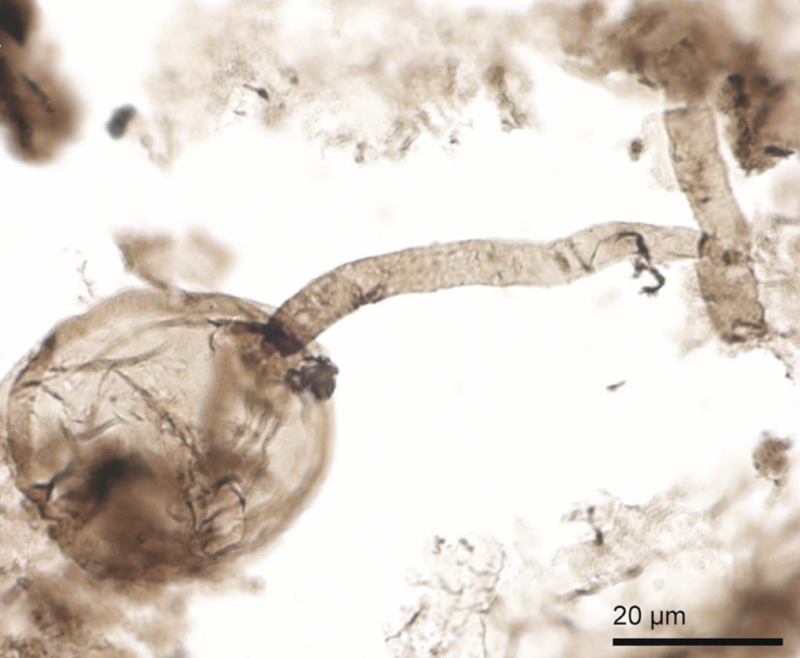
When did the first complex multicellular life arise? Most people, being a bit self-centered, would point to the Ediacaran and Cambrian, when the first animal life appeared and then diversified. Yet studies of DNA suggest that fungi may have originated far earlier than animals.
When it comes to a fossil record, however, things are rather sparse. No unambiguous evidence of a fungus appears in fossils until after the Cambrian was over. A few things from earlier may have looked fungus-like, but the evidence was limited to their appearance. It could be that fungi branched off at the time suggested by the DNA but didn't evolve complex, multicellular structures until later. Alternatively, the fossils could be right, and there's something off about the DNA data. Or, finally, it could be that we simply haven't found old enough fossils yet.
A new paper out in today's Nature argues strongly for the last option. In it, a small team of researchers describe fossils of what appear to be fungi that could be up to a billion years old. And the researchers back up the appearance with a chemical analysis.
Really, really old
The fossils come from an area on Canada's northern, Arctic coast. The fossils themselves were discovered by dissolving the minerals that contained them with acid. With the rocks gone, a large collection of small fossils floated free.
Visually, these microfossils look like a partially deflated balloon with a stalk at its base. Those stalks are connected to a long tube that can link up multiple balloon-like structures. This looks a lot like some modern fungi, where the balloon-like structure is a source of spores while the tubes are how the organism grows and spreads within a surface. One critical feature that's shared with fungi is the fact that the stalk that attaches the sphere to the rest of the organism branches off at a right angle. The structure provided the new genus' name, Ourasphaira, for tail and sphere; the full species name is Ourasphaira giraldae.

That, by itself, isn't shocking. What's startling is how old these fossils are. While the layer they reside in hasn't been subjected to dating, nearby layers have. A layer below has been identified as being as much as a billion years old. On the other side of the stratiographic sandwich, there's a layer that is about 900 million years old. These provide a 100-million-year-long window during which the fossils could have been deposited. But even at their youngest, these fossils are about a half -billion years older than the previous oldest fungus we've found.
So, supporting the claim that these are actually fungi becomes critical. To do so, the researchers took a closer look at the cell wall using an electron microscope and showed that, like a fungus, the cell wall is bi-layered. And chemically, the wall looked like it contained derivatives of chitin, a complex polymer of sugars that forms the cell wall of modern fungi. While other organisms make chitin—it's a key component of the insect exoskeleton, for example—many of these organisms clearly evolved later, and none of them looks anything like Ourasphaira giraldae.
The presence of chitin is consistent with the samples holding up to the acid treatment that dissolved away the surrounding rock. And an examination of the rock layer indicated that it probably hasn't been heated above 200°C since it was formed, which is low enough that the chitin was likely to have survived intact.
All of this, the researchers argue, makes a compelling case that Ourasphaira giraldae really is a fungus, despite its apparent age. They argue that it's part of a precursor group that ultimately gave rise to Dikarya, a subkingdom that includes mushrooms.
What’s it doing there?
Perhaps the sentence above should read "consistent with its apparent age," rather than "despite." As mentioned earlier, studies of the gene content and sequence of fungi indicated that they had originated long before animals, and some work had even suggested an age in the neighborhood of 900 million years. So, the data suggests that the fossils are from around the time that fungi originated. As such, the findings help anchor the molecular data in time, which should improve our estimates of when plants and animals branched off from the world of one-celled eukaryotes.
A key question, however, is what fungi were doing there. At present, most fungal species are land-based, but the rocks were deposited in an estuary environment. It's not clear whether the fossils originated there or were simply deposited in the sediments there as they formed.
Fungi currently play a key role in helping break down complex tissues of other multicellular organisms, making nutrients and other organic material available to the ecosystem. It's possible they played a similar role in helping break down the complex structures formed by communities of bacteria prior to the emergence of animal and plant life. As one half of the symbiotic team that forms lichens, fungi also help colonize what's otherwise bare rock; in that role, they may have been critical in preparing land for invasion by other forms of complex life.
Understanding more about the lifestyle of the first fungi, however, will probably have to wait for a way of identifying them without acid-dissolving the entire remains of the ecosystem they lived in.
While the paper linked below makes the argument that Ourasphaira giraldae is a fungus, an earlier paper describes its discovery, along with a set of other microfossil species.
Nature, 2019. DOI: 10.1038/s41586-019-1217-0 (About DOIs).
reader comments
49